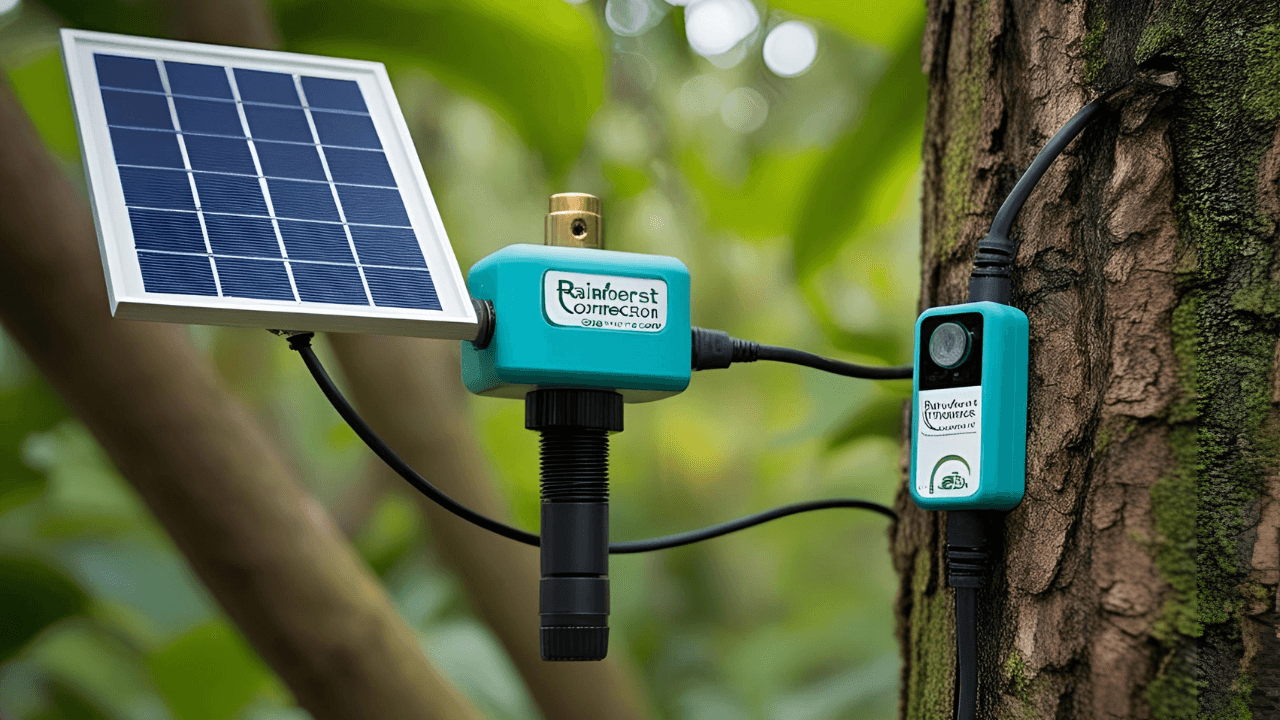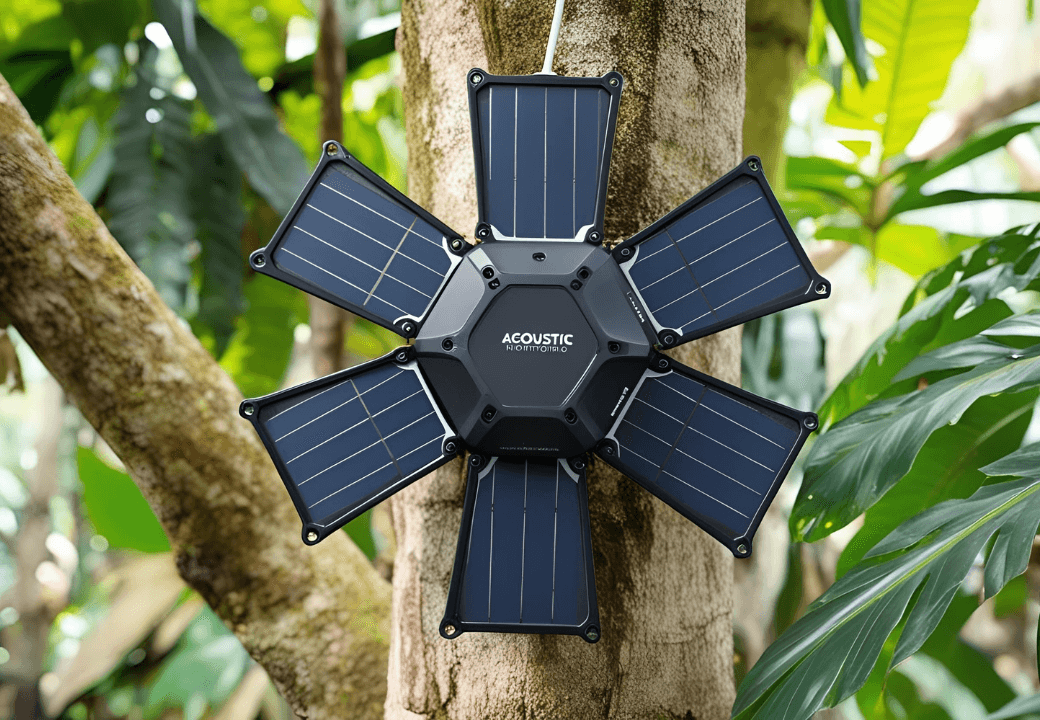🎵 Introduction: The Symphony of the Forest
Forests are not just a collection of trees; they are vibrant ecosystems teeming with life, each contributing to a complex and dynamic forest soundscape. The chirping of birds and the gentle whisper of leaves blend together in a harmonious soundscape, offering a living soundtrack that reveals the richness and well-being of the ecosystem.
Recent advancements in technology have enabled scientists to harness these sounds through acoustic monitoring forests, a method that involves recording and analyzing the ambient sounds of forest ecosystems. This approach provides invaluable insights into biodiversity, species behavior, and environmental changes without intrusive human intervention. By capturing the nuances of the forest soundscape, researchers can detect patterns and anomalies that may indicate ecological shifts or threats, such as illegal logging or habitat degradation.

One notable initiative in this field is SoundNet, an umbrella term for integrated technologies that utilize acoustic monitoring forests to listen to and interpret the forest soundscape. Projects like Rainforest Connection have implemented solar-powered recording devices in treetops to collect real-time audio data, which is then analyzed using artificial intelligence to identify specific sounds associated with environmental disturbances or wildlife activity. (WIRED)
The application of acoustic monitoring forests and analysis of the forest soundscape not only enhances our understanding of these ecosystems but also empowers conservation efforts by providing timely and accurate data. This innovative approach underscores the importance of listening to nature’s own signals to protect and preserve our planet’s forests.
🧠 The Technology Behind SoundNet
SoundNet is powered by a groundbreaking blend of advanced acoustic monitoring and AI-driven conservation tools, developed by the visionary nonprofit Rainforest Connection. Their flagship solution, the Guardian device, exemplifies how technology can be harnessed to protect our planet’s most vital ecosystems.
🌲 Guardian Devices: The Forest’s Ears
Rainforest Connection‘s Guardian devices are solar-powered, weather-resistant units strategically installed high in the forest canopy. Equipped with sensitive microphones, these devices continuously capture the ambient sounds of the forest, creating a rich tapestry of real-time acoustic data. This data encompasses a range of sounds—from the calls of wildlife to the distant hum of chainsaws—providing invaluable insights into the forest’s health and any potential threats.
The Guardian devices are designed to operate autonomously, powered by solar panels that harness sunlight filtering through the canopy. They are equipped with onboard processing capabilities and can transmit data via GSM, Wi-Fi, or satellite networks, ensuring connectivity even in remote locations. (Rainforest Connection)
☁️ Cloud-Based AI Analysis
Once the real-time acoustic data is collected, it’s transmitted to cloud servers where advanced AI conservation technology comes into play. Machine learning algorithms analyze the audio streams, distinguishing between natural forest sounds and anomalies indicative of human intrusion, such as chainsaws, gunshots, or vehicles. This rapid analysis enables immediate alerts to be sent to conservation teams, facilitating swift responses to illegal activities.
The AI models are trained on extensive datasets of environmental sounds, allowing them to recognize specific acoustic signatures with high accuracy. This capability not only aids in detecting threats but also contributes to biodiversity monitoring by identifying species-specific calls and tracking their presence over time.
📱 Real-Time Alerts and Field Response
To ensure timely intervention, Rainforest Connection provides a mobile application that delivers real-time alerts to rangers and conservationists. When the AI detects a potential threat, such as illegal logging, the system sends a notification with the precise location and nature of the disturbance. This empowers field teams to respond promptly, increasing the chances of preventing environmental crimes and protecting vulnerable wildlife.
The integration of real-time acoustic data analysis and immediate communication channels exemplifies how AI conservation technology can enhance the effectiveness of on-the-ground conservation efforts.
🌐 Global Impact and Scalability
Since its inception, Rainforest Connection has deployed over 580 Guardian devices across 35 countries, monitoring more than 1 million acres of land. The scalability of this approach demonstrates its potential to be a game-changer in global conservation strategies. rfcx.org
By leveraging AI conservation technology and real-time acoustic data, SoundNet represents a transformative step forward in our ability to monitor and protect the world’s forests. This synergy of technology and ecology offers a proactive approach to preserving biodiversity and combating environmental threats.
🌍 Real-World Impact: Case Studies
The integration of bioacoustic monitoring and AI conservation technology by Rainforest Connection has led to significant advancements in forest conservation across various regions. By deploying their Guardian devices, they’ve enabled real-time detection of illegal activities and facilitated biodiversity monitoring. Let’s explore some notable case studies:
Indonesia: Empowering Indigenous Communities
In West Sumatra, Indonesia, Rainforest Connection partnered with local NGO KKI Warsi and indigenous communities to combat rampant illegal logging. Guardian devices were installed in the Mudiak Badou landscape, a region threatened by land-based concessions like oil palm plantations and mining. These devices, utilizing illegal logging detection AI, provided real-time alerts to rangers, enabling swift responses to unauthorized activities. This collaboration not only reduced deforestation but also empowered local communities to take an active role in forest conservation. (Huawei BLOG- RFCx Technology)

Inside Costa Rica’s Wild Heart: How AI Is Tracking Biodiversity in the AmistOsa Corridor
In Costa Rica, researchers from the National University employed bioacoustic monitoring to study ecosystems within the AmistOsa Biological Corridor. By analyzing sound recordings, they could monitor biodiversity and assess conservation efforts, focusing on species like the bellbird. This approach allowed for the detection of ecological changes and threats, providing valuable data to inform conservation strategies. (WIRED)
Ecuador: Tracking Forest Recovery in the Chocó Region
In Ecuador’s Chocó region—one of the world’s richest biodiversity hotspots—researchers are using bioacoustic monitoring combined with AI to track how wildlife returns to recovering forests. Their findings reveal that within just 25 years, regenerating areas begin to echo once again with the sounds of nature, signaling significant strides in ecological recovery across varying landscapes. This method proved to be a powerful and cost-effective technique for assessing biodiversity levels in restored forests, including insects and animals that don’t vocalize.
⚖️ Challenges and Ethical Considerations
While AI environmental monitoring technologies like SoundNet offer transformative potential for forest conservation, they also present a range of technical challenges and ethical dilemmas that must be carefully navigated.
🔌 Overcoming Technical Hurdles: Powering Devices, Ensuring Reliable Data, and Staying Connected in Remote Terrain
Connectivity: Deploying AI-driven acoustic monitoring systems in remote forest areas often encounters significant connectivity issues. Dense vegetation and rugged terrains can impede signal transmission, making it difficult to relay data in real-time. Solutions such as satellite communication and mesh networks are being explored to overcome these obstacles, but they come with increased costs and complexity.
Power Supply: Ensuring a reliable power source for monitoring devices is another critical challenge. Solar panels are commonly used, but their efficiency can be compromised by canopy cover and weather conditions. Energy storage solutions like high-capacity batteries are essential, yet they add to the logistical and financial burdens of deployment.
Data Accuracy: The effectiveness of AI environmental monitoring hinges on the quality of data collected. Environmental factors such as background noise, weather conditions, and wildlife activity can introduce noise into acoustic data, potentially leading to false positives or negatives. Advanced algorithms and machine learning models are continually being refined to improve data filtering and interpretation accuracy.
🧭 Ethical Considerations: Surveillance vs. Indigenous Rights
The deployment of AI environmental monitoring systems raises significant forest surveillance ethics concerns, particularly regarding the rights and privacy of Indigenous communities.
Surveillance Concerns: While the primary goal of these technologies is to monitor environmental changes and illegal activities, there is a risk that they could inadvertently infringe upon the privacy of local communities. Continuous audio recording may capture conversations or cultural practices, leading to potential misuse or unintended consequences.
Indigenous Rights: Indigenous communities often inhabit the forests targeted for monitoring. Implementing surveillance technologies without their informed consent can violate their rights and disrupt their traditional ways of life. It’s crucial to engage these communities in the planning and deployment processes, ensuring that their knowledge and perspectives are respected and integrated.
🔍 Transparency and Consent in Deploying Acoustic AI
Informed Consent: Obtaining explicit consent from local and Indigenous communities before deploying monitoring technologies is essential. This involves transparent communication about the purpose, scope, and potential impacts of the surveillance systems.
Data Governance: Establishing clear protocols for data collection, storage, and usage is vital to maintain trust and accountability. Communities should have access to the data collected and a say in how it’s used, ensuring that the benefits of monitoring are shared equitably.
Collaborative Approaches: Engaging local communities as active participants in monitoring efforts can enhance the effectiveness and ethical standing of conservation initiatives. Training and employing community members to manage and interpret data fosters a sense of ownership and ensures that monitoring aligns with local values and needs.
Navigating the technical and ethical complexities of AI environmental monitoring requires a balanced approach that prioritizes both environmental protection and the rights of local communities. By addressing connectivity and power challenges, ensuring data accuracy, and upholding forest surveillance ethics, we can harness the power of technology to safeguard our forests responsibly.
🔮 The Future of AI-Powered Forest Monitoring
Looking forward, artificial intelligence stands poised to revolutionize conservation efforts, offering unprecedented tools for monitoring, protecting, and understanding our planet’s biodiversity. Building upon the successes of initiatives like SoundNet, environmental AI innovations are poised to expand beyond forests, transforming how we monitor and protect diverse ecosystems across the globe.
🌊 Expanding Horizons: From Forests to Oceans, Deserts, and Cities
The application of AI in conservation is not limited to forested areas. In marine environments, AI technologies are revolutionizing ocean protection by processing vast amounts of data from satellites, sonar systems, underwater drones, and sensor networks. This enables the detection of pollution patterns, forecasting of harmful algal blooms, and identification of illegal activities such as overfishing . (PHAROS Project)
In arid regions, AI-powered drones and IoT sensors are being utilized to monitor desertification processes, track wildlife movements, and assess the health of sparse vegetation. Urban environments also benefit from environmental AI innovation, with AI systems analyzing data from various sources to monitor air quality, green spaces, and urban biodiversity .
🛰️ Integrating Satellites, Drones, and IoT: A Synergistic Approach
The convergence of AI with satellites, drones, and IoT technologies marks a transformative shift in environmental monitoring. Satellite systems offer broad, real-time insights into shifts in land use, vegetation vitality, and evolving climate dynamics—empowering faster and more accurate decision-making in conservation efforts. Drones offer high-resolution imagery and the ability to access hard-to-reach areas, while IoT sensors collect granular data on environmental parameters such as temperature, humidity, and pollutant levels.
By combining these technologies, AI systems can analyze and interpret complex datasets, enabling more accurate predictions and timely interventions. For instance, AI algorithms can process satellite imagery to detect illegal logging activities, while drones equipped with AI can monitor wildlife populations and their habitats .
🤝 Empowering Community-Based Conservation Through AI
A critical aspect of the future of AI in conservation is its potential to empower local communities. Environmental AI innovations are increasingly being designed to support community-based conservation efforts, ensuring that those who are most affected by environmental changes have the tools and knowledge to respond effectively.
AI-powered platforms can facilitate citizen science initiatives, allowing individuals to contribute data on local biodiversity, report environmental threats, and participate in conservation planning. When local communities are actively engaged in data collection and environmental decision-making, AI becomes a tool for empowerment—cultivating a deeper sense of ownership, accountability, and long-term commitment to conservation efforts.
In summary, the future of AI in conservation is marked by the expansion of environmental AI innovations across various ecosystems, the integration of advanced technologies for comprehensive monitoring, and the empowerment of communities to actively participate in conservation efforts. As these developments continue to unfold, they hold the potential to significantly enhance our ability to protect and preserve the natural world.
🟢Conclusion: Listening to Save Our Planet
In a world facing accelerating climate and biodiversity crises, the idea of “listening” to nature has gone from poetic to practical. Forests are not silent—they hum, crackle, echo, and call. Within these complex soundscapes lie clues about the health of ecosystems, the presence of endangered species, and the threats they silently face. Through the development of bioacoustic AI solutions, we’re beginning to understand and act on these natural messages in ways never before possible.
The rise of AI for nature conservation marks a pivotal shift in how we protect our environment. No longer limited to satellite images or physical patrols, we now have the tools to monitor ecosystems in real time, identify illegal activity as it happens, and respond proactively. Projects like Rainforest Connection have already demonstrated that this approach can reduce illegal logging, aid species recovery, and build local conservation capacity.
But for this future to scale, it needs awareness, support, and continued innovation. Whether you’re a policymaker, technologist, conservationist, or simply someone who cares about the planet, supporting projects that use AI for nature conservation helps advance the global effort to preserve our biosphere.
In essence, bioacoustic AI solutions are giving us ears in the forest—and a voice in deciding the planet’s future. By listening better, we can protect smarter.
If you’re fascinated by how technology is transforming our connection with nature, you might also enjoy these articles:
👉 Swarm Robotics for Environmental Monitoring – Discover how swarms of small robots are being used to monitor ecosystems, track pollution, and gather real-time environmental data with high efficiency.
👉 AI in Wildlife Conservation – Learn how artificial intelligence is helping protect endangered species through smart tracking, image recognition, and poaching prevention.
👉 AI in Climate Change – Explore how AI models are being used to predict climate patterns, reduce emissions, and create innovative solutions to tackle global warming.
👉 Harnessing AI in Predicting Natural Disasters – See how AI is revolutionizing disaster preparedness by forecasting events like floods, wildfires, and earthquakes before they strike.






